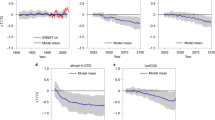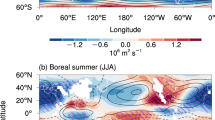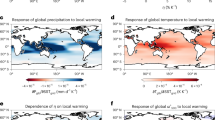Abstract
During summertime, monsoons and subtropical anticyclones shape precipitation and regional circulation patterns across the globe. In state-of-the-art climate models, the average response of the Asian monsoon cyclone, Pacific ocean anticyclone and jet stream to global warming is weak and responses of different models are diverse. Here we use a suite of simulations with atmospheric general circulation models with prescribed sea surface temperatures to separate the circulation responses to direct radiative forcing and indirect sea surface temperature warming. We find that the two contributions oppose each other. Using idealized aquaplanet simulations, we show that the different circulation responses are directly connected to the opposite responses of land–sea thermal contrast to the two forcing components. This tug of war on the circulation response to global warming is analogous to the seasonal response to insolation, which involves opposite land–sea thermal contrasts and circulation patterns governed by quasi-equilibrium thermodynamics and stationary-wave dynamics. We conclude that it is important to distinguish weak circulation responses to global warming that arise owing to compensating effects that are robust and physically understood from those that are associated with genuine uncertainty. We note that compensation places fundamental limits on the detection and attribution of circulation responses to global warming.
This is a preview of subscription content, access via your institution
Access options
Subscribe to this journal
Receive 12 print issues and online access
$259.00 per year
only $21.58 per issue
Buy this article
- Purchase on Springer Link
- Instant access to full article PDF
Prices may be subject to local taxes which are calculated during checkout





Similar content being viewed by others
References
Webster, P. J. Response of the tropical atmosphere to local, steady forcing. Mon. Weath. Rev. 100, 518–541 (1972).
Gill, A. E. Some simple solutions for heat-induced tropical circulation. Q. J. R. Meteorol. Soc. 106, 447–462 (1980).
Ting, M. Maintenance of the Northern Summer stationary waves in a GCM. J. Atmos. Sci. 51, 3286–3308 (1994).
Wang, H. & Ting, M. Seasonal cycle of the climatological stationary waves in the NCEP-NCAR reanalysis. J. Atmos. Sci. 56, 3892–3919 (1999).
Rodwell, M. J. & Hoskins, B. J. Subtropical anticyclones and summer monsoons. J. Clim. 14, 3192–3211 (2001).
Chen, P., Hoerling, M. P. & Dole, R. The origin of subtropical anticyclones. J. Atmos. Sci. 58, 1827–1835 (2001).
Webster, P. & Fasullo, J. in Encyclopedia of Atmospheric Sciences (eds Holton, J. R., Curry, J. A. & Pyle, J. A.) 1370–1391 (Academic Press, 2003).
Seager, R. et al. Air–sea interactions and the seasonal cycle of the subtropical anticyclones. J. Clim. 16, 1948–1966 (2003).
Liu, Y., Wu, G. & Ren, R. Relationship between the subtropical anticyclone and diabatic heating. J. Clim. 17, 682–698 (2004).
Chen, T-C. Characteristics of summer stationary waves in the Northern Hemisphere. J. Clim. 23, 4489–4507 (2010).
Shaw, T. A. On the role of planetary-scale waves in the abrupt seasonal transition of the Northern Hemisphere general circulation. J. Atmos. Sci. 71, 1724–1746 (2014).
IPCC Climate Change 2013: The Physical Science Basis (eds Stocker, T. F. et al.) (Cambridge Univ. Press, 2013).
Christiansen, J. H. et al. in Climate Change 2013: The Physical Science Basis (eds Stocker, T. F. et al.) Ch. 14, 1217–1308 (IPCC, Cambridge Univ. Press, 2013).
Manabe, S., Stouffer, R. J., Spelman, M. K. & Bryan, K. Transient responses of a coupled ocean-atmosphere model to gradual changes of atmospheric CO2. Part I: Annual mean response. J. Clim. 4, 785–818 (1991).
Kamae, Y., Watanabe, M., Kimoto, M. & Shiogama, H. Summertime land–sea thermal contrast and atmospheric circulation over East Asia in a warming climate—Part I: Past changes and future projections. Clim. Dynam. 43, 2553–2568 (2014).
Kamae, Y., Watanabe, M., Kimoto, M. & Shiogama, H. Summertime land–sea thermal contrast and atmospheric circulation over East Asia in a warming climate—Part II: Importance of CO2-induced continental warming. Clim. Dynam. 43, 2569–2583 (2014).
Li, W., Li, L., Ting, M. & Liu, Y. Intensification of the Northern Hemisphere subtropical highs in a warming climate. Nature Geosci. 5, 830–834 (2012).
Bakun, A. Global climate change and the intensification of coastal ocean upwelling. Science 247, 198–201 (1990).
Yin, J. H. A consistent poleward shift of the storm tracks in simulations of 21st century climate. Geophys. Res. Lett. 32, L18701 (2005).
Lorenz, D. J. & DeWeaver, E. Tropopause height and zonal wind response to global warming in the IPCC scenario integrations. J. Geophys. Res. 112, D10119 (2007).
Barnes, E. A. & Polvani, L. M. Response of the midlatitude jets, and their variability, to increased greenhouse gases in the CMIP5 models. J. Clim. 26, 7117–7135 (2013).
Simpson, I. R., Shaw, T. A. & Seager, R. A diagnosis of the seasonally and longitudinally varying mid-latitude circulation response to global warming. J. Atmos. Sci. 71, 2489–2515 (2014).
Taylor, K. E., Stouffer, R. J. & Meehl, G. A. An overview of CMIP5 and the experiment design. Bull. Am. Meteorol. Soc. 93, 485–498 (2012).
Deser, C. & Phillips, A. S. Atmospheric circulation trends, 1950–2000: The relative roles of sea surface temperature forcing and direct atmospheric radiative forcing. J. Clim. 22, 396–413 (2009).
Li, H., Dai, A., Zhou, T. & Lu, J. Responses of East Asian summer monsoon to historical SST and atmospheric forcing during 1950–2000. Clim. Dynam. 34, 501–514 (2010).
Bony, S. et al. Robust direct effect of carbon dioxide on tropical circulation and regional precipitation. Nature Geosci. 6, 447–451 (2013).
Grise, K. M. & Polvani, L. M. The atmospheric circulation response to increased CO2: The relative roles of sea surface temperature forcing and direct atmospheric radiative forcing. Geophys. Res. Lett. 41, 6863–6871 (2014).
Nie, X., Boos, W. R. & Kuang, Z. Observational evidence of a quasi-equilibrium view of monsoons. J. Clim. 23, 4416–4428 (2010).
Hurley, J. V. & Boos, W. R. Interannual variability of monsoon precipitation and local subcloud equivalent potential temperature. J. Clim. 26, 9507–9527 (2013).
Emanuel, K. A. On thermally direct circulation in moist atmospheres. J. Atmos. Sci. 52, 1529–1534 (1995).
Lindzen, R. S. & Nigam, S. On the role of sea surface temperature gradients in forcing winds and convergence in the tropics. J. Atmos. Sci. 44, 2418–2436 (1985).
Prive, N. & Plumb, A. Monsoon dynamics with interactive forcing. Part I: Axisymmetric studies. J. Atmos. Sci. 64, 1417–1430
Sardeshmukh, P. D. & Hoskins, B. J. The generation of global rotational flow by steady idealized tropical divergence. J. Atmos. Sci. 45, 1228–1251 (1988).
Allen, M. R. & Ingram, W. J. Constraints on future changes in climate and the hydrological cycle. Nature 419, 224–232 (2002).
Ma, D., Boos, W. R. & Kuang, Z. Effects of orography and surface heat fluxes on the South Asian Summer Monsoon. J. Clim. 27, 6647–6659 (2014).
Byrne, M. & O’Gorman, P. Land–ocean warming contrast over a wide range of climates: Convective quasi-equilibrium theory and idealized simulations. J. Clim. 26, 4000–4016 (2013).
McLandress, C. et al. Separating the dynamical effects of climate change and ozone depletion. Part II: Southern Hemisphere troposphere. J. Clim. 24, 1850–1868 (2011).
Polvani, L. M., Waugh, D. W., Correa, G. & Son, S-W. Stratospheric ozone depletion: The main driver of twentieth-century atmospheric circulation changes in the Southern Hemisphere. J. Clim. 24, 795–812 (2011).
Perlwitz, J. Tug of war on the jet stream. Nature Clim. Change 1, 29–31 (2012).
Held, I. M. Large-scale dynamics and global warming. Bull. Am. Meteorol. Soc. 74, 228–241 (1993).
Butler, A. H., Thompson, D. W. J. & Heikes, R. The steady-state atmospheric circulation response to climate change-like thermal forcings in a simple general circulation model. J. Clim. 23, 3474–3496 (2010).
Bollasina, M. A., Ming, Y. & Ramaswamy, V. Anthropogenic aerosols and the weakening of the South Asian Monsoon. Science 334, 502–505 (2011).
Li, X., Ting, M., Li, C. & Henderson, N. Mechanisms of Asian summer monsoon changes in response to anthropogenic forcing in CMIP5 models. J. Clim. http://dx.doi.org/10.1175/JCLI-D-14-00559.1 (2015)
Sardeshmukh, P. D. & Hoskins, B. J. Spatial smoothing on the sphere. Mon. Weath. Rev. 112, 2524–2529 (1984).
Seager, R. & Henderson, N. Diagnostic computation of moisture budgets in the ERA-Interim reanalysis with reference to analysis of CMIP-archived atmospheric model data. J. Clim. 26, 7876–7901 (2013).
Dee, D. P. et al. The ERA-Interim reanalysis: Configuration and performance of the data assimilation system. Q. J. R. Meteorol. Soc. 137, 553–597 (2011).
Li, J. P. & Zeng, Q. C. A unified monsoon index. Geophys. Res. Lett. 29, 1151–1154 (2002).
Stevens, B. et al. Atmospheric component of the MPI-M Earth System Model: ECHAM6. J. Adv. Model. Earth Syst. 5, 146–172 (2013).
Neale, R. & Hoskins, B. J. A standard test for AGCMs including their physical parameterizations. Part I: The proposal. Atmos. Sci. Lett. 1, 101–107 (2001).
Acknowledgements
T.A.S. and A.V. are supported by the David and Lucile Packard Foundation. T.A.S. acknowledges support from the National Science Foundation (Grant AGS-125520). We thank I. Simpson, R. Seager, M. Ting and A. Sobel for helpful discussions and N. Henderson and H. Liu for help downloading the CMIP5 data. We acknowledge the World Climate Research Programme’s Working Group on Coupled Modelling, which is responsible for CMIP, and we thank the climate modelling groups (listed in the Supplementary Methods) for producing and making available their model output. For CMIP the US Department of Energy’s Program for Climate Model Diagnosis and Intercomparison provides coordinating support and led development of software infrastructure in partnership with the Global Organization for Earth System Science Portals.
Author information
Authors and Affiliations
Contributions
T.A.S. designed the study, performed the analysis and wrote the manuscript. A.V. and T.A.S. performed the aquaplanet model simulations. Both authors discussed and interpreted the results and edited the manuscript.
Corresponding author
Ethics declarations
Competing interests
The authors declare no competing financial interests.
Supplementary information
Supplementary Information
Supplementary Information (PDF 6335 kb)
Rights and permissions
About this article
Cite this article
Shaw, T., Voigt, A. Tug of war on summertime circulation between radiative forcing and sea surface warming. Nature Geosci 8, 560–566 (2015). https://doi.org/10.1038/ngeo2449
Received:
Accepted:
Published:
Issue Date:
DOI: https://doi.org/10.1038/ngeo2449
This article is cited by
-
The subseasonal predictability of the western North Pacific subtropical high and the 2020 record-breaking event
npj Climate and Atmospheric Science (2024)
-
Robust changes in global subtropical circulation under greenhouse warming
Nature Communications (2024)
-
Projected increase in summer heat-dome-like stationary waves over Northwestern North America
npj Climate and Atmospheric Science (2023)
-
Zonally asymmetric component of summer surface temperature trends caused by intraseasonal time-scale processes
npj Climate and Atmospheric Science (2023)
-
Distinctive changes of Asian–African summer monsoon in interglacial epochs and global warming scenario
Climate Dynamics (2023)



